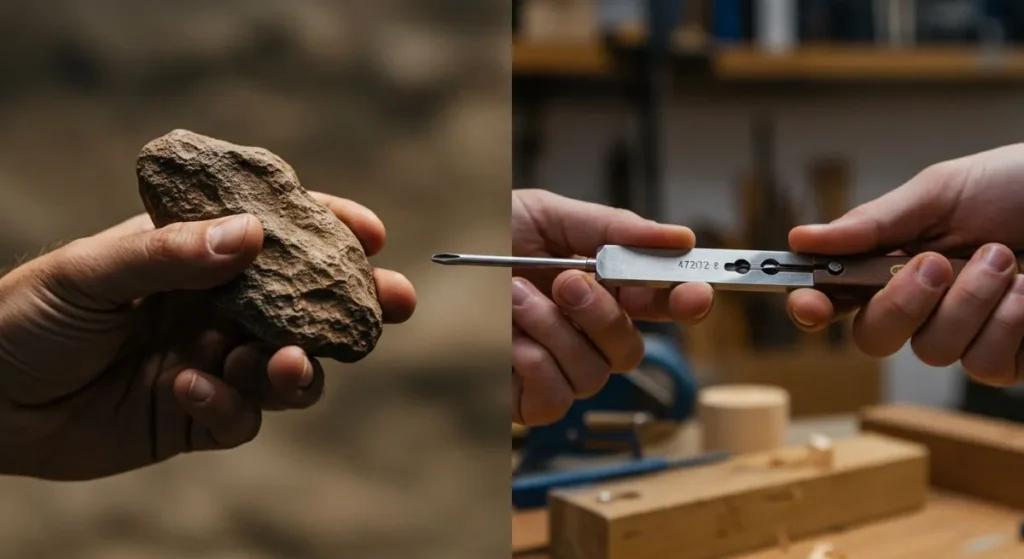Marking a crucial point in the history of hand tools, a 3.3-million-year-old tool found in northern Kenya tells the first chapter of humanity’s tool-making story. Our ancestors turned this simple stone hammer into something more useful by adding a wooden handle and twine – the first step in our long journey of innovation.
The story of tools flows from these basic beginnings through the Bronze and Iron Ages. Metal tools changed everything about farming and crafts during these periods. The hand tools industry stands strong today at valued at US $23.8 billion in 2023. The legacy runs deep – from simple pruning knives seen in Roman artwork to today’s state-of-the-art smart tools. This piece will reveal the untold stories, sacred meanings, and forgotten techniques behind these tools that built human civilization.
Archeological findings tell us fascinating stories about ancient craftsmanship. Traditional knowledge still shapes modern tool design in surprising ways. The tools of our ancestors have left their mark on today’s technology and manufacturing in ways you might not expect.
Disclaimer
The information in this article (History Of Hand Tools) is based on historical and archaeological research as of April 2025. Interpretations and scientific understanding, particularly regarding ancient theories or techniques, may evolve with discoveries. This content is planned for general informational and educational purposes only and does not constitute professional advice. While sources are cited for credibility, we are not responsible for the accuracy or content of external websites.
Archeological Discoveries Revealing Ancient Tool Secrets

Recent discoveries have drastically changed what we know about early humans and their tools. A team of archeologists found that there was evidence of stone tools dating back approximately 3.3 million years at Nyayanga, Kenya. These tools are 700,000 years older than previous estimates 1. The findings raise intriguing questions about which species made these ancient tools.
Unexpected Findings in Prehistoric Tool Sites
The team’s work in Kenya’s Homa Peninsula revealed flakes with sharp edges that could peel fruits and cut meat from large animals like hippos 2. The researchers also found two Paranthropus molars near these tools. This discovery challenges our belief that only our direct ancestors in the Homo genus knew how to make tools 3. Cut marks on hippo bones from the same layer prove that early humans used stone tools for butchery 3.3 million years ago 1.
Image Disclosure:
Some illustrations in this post ( History of Hand Tools ) have been generated using AI technology to help visualize historical concepts and artifacts where authentic images may not exist or be readily available. The textual content remains based on research and cited sources.
How Modern Technology Unlocks Ancient Tool Mysteries
The digital world has changed how archeologists work in the field. They now combine traditional methods with new digital tools. Teams use drone imaging, laser rangefinders, and magnetometry to spot promising sites without digging extensively 4. Ground-penetrating radar helps them map underground structures before they start digging 4.
Labs now use specialized software like PyLithics to study stone tools much faster than human experts 5. The software completes in one week what would take an expert ten years to do 5. X-ray and CT scanning let scientists study artifacts without damaging them while revealing their internal structures 4.
The Oldowan Tools: First Evidence of Human Ingenuity

The Oldowan toolkit shows humanity’s first systematic stone technology. These tools include:
- Hammerstones with signs of battering on surfaces
- Stone cores showing flake scars along edges
- Sharp stone flakes with useful cutting edges 6
Scientists once linked these tools only to Homo habilis (“handy man”), but new evidence shows they were used more widely 3. The sophisticated nature of Oldowan toolmaking changed how our ancestors lived. As one researcher noted, “Tool use fundamentally altered the way our early ancestors interacted with nature, allowing them to eat new types of food and exploit new territories” 7. These tools gave early humans “a brand new set of teeth outside the body,” which helped them eat different foods and adapt to new environments 33.
Sacred Symbolism: Tools Beyond Practical Use
Ancient civilizations saw tools as more than just practical objects – they became powerful symbols filled with spiritual meaning. Archeological evidence reveals that people imbued many artifacts with supernatural powers, which bridged the gap between physical and spiritual worlds 9.
Ceremonial Tools in Ancient Civilizations
Egyptian archeologists have found amazing collections of ritual items. These include statues of the fertility goddess Taweret, pure gold Ujat eyes, and ceremonial clay figurines dedicated to goddess Hathor 10. These objects served religious ceremonies rather than practical purposes. Ancient Palestine’s ring vessels featured symbolic animals like doves and pomegranates. People used these vessels in fertility rituals, pouring liquids through channels to represent earth’s abundance 11.
Blacksmith Gods and Tool Worship Across Cultures
People held the art of smithing in high regard, which elevated blacksmiths to an almost magical status. Many cultures created specific deities linked to metalworking and craftsmanship. The Greek god Hephaestus created magnificent equipment for other gods. His work included Hermes’ winged helmet, Aegis breastplate, and Achilles’ armor 12. Norse mythology had its dwarves and elves who mastered blacksmithing, while Celtic cultures praised Goibniu, the god who made perfect weapons 13.
The worship of Vishwakarma, known as the “Maker of the Universe,” continues in India today. Artisans put down their tools periodically to honor them in ritual ceremonies. The tools themselves become objects of worship 14. This tradition now includes modern devices like cars and computers 14.
Hidden Meanings in Tool Decorations and Designs
Ancient tools carried intricate decorations that told complex cultural stories, despite their practical uses. To name just one example, people believed Charlemagne’s sword Joyeuse’s decoration protected against poison supernaturally 15. Tools meant more than just utility throughout history. The size and placement of decorative elements showed social hierarchies, with specific colors or symbols marking royal or religious importance 16.
Archeological studies show how these symbolic elements help us learn about ancient belief systems, social structures, and worldviews we might never have understood otherwise 17.
Lost Techniques of Master Craftsmen
Ancient craftsmen created remarkable tools using techniques that have mysteriously disappeared over time. These lost methods showcase not just technical skills but also the brilliance of master artisans. Their secrets vanished with their death or got lost during historical upheavals.
Damascus Steel: The Recipe We Lost
Damascus steel’s legendary status comes from its unique watery pattern and amazing strength. The last known production stopped by the late 19th century, with final documentation from 1903 in Sri Lanka 18. Several factors led to its disappearance:
- Trade routes broke down, cutting access to specific raw materials
- Knowledge about key trace elements like tungsten, vanadium, or manganese faded away
- The controlled thermal cycling techniques were forgotten
- British Raj’s production taxes and export bans affected knowledge sharing 18
Scientists have tried to recreate Damascus steel with little success. The original process needed specific ore compositions that no longer exist 19.
Ancient Egyptian Copper Working Methods
Egyptian coppersmiths became skilled at complex casting techniques during the Fourth Dynasty. Bronze later replaced copper, but early pyramid builders used copper chisels and saws to cut limestone 20. These craftsmen developed ways to create incredibly thin copper bowls through exact casting 21. The lost wax (cire perdue) method became their invention. They coated beeswax models with clay, heated them to melt the wax, then poured molten metal 21.
Japanese Blade Folding Traditions
Japanese swordmaking involves folding steel (shita-kitae) 10-20 times, sometimes creating blades with millions of layers 22. This technique solved problems with impurities in traditional tamahagane steel. Medieval furnaces could only reach 2,500°F instead of the needed 2,800°F 22. The folding let oxygen burn away impurities while creating the distinctive jihada (grain pattern) on finished blades 23.
Tools That Built the Pyramids: Theories and Evidence
Builders used copper chisels for softer limestone and pounded harder stones with dolerite and abrasive sands 24. They moved blocks on wooden sleds over wet ground to reduce friction 25. Scientists found a new branch of the Nile, the Ahramat Branch, that helped transport materials 24. Recent research suggests they might have used hydraulic technology to lift massive stones 26.
How Ancient Knowledge Shapes Modern Tools
Modern hand tools share remarkable similarities with their ancient counterparts. Archeological records show that many design principles we think of as innovative today were actually found thousands of years ago by our earliest toolmaking ancestors.
Ergonomic Principles Found Thousands of Years Ago
The science of ergonomics, which creates tools that work efficiently with human anatomy, dates back to prehistoric times. Archeological evidence confirms that the first stone tools incorporated ergonomic principles 27. Hippocrates explained in the fifth century B.C. how a surgeon should arrange their workspace and tools to maximize safety and efficiency 28.
Ancient Egyptian dynasties made household equipment that showed clear ergonomic principles 27. They focused on user comfort and effectiveness. The Greeks had an impressive grasp of intuitive design—their pot handles stand out as excellent examples of ergonomic thinking 29.
Scientists have made fascinating discoveries about the relationship between hands and Lower Paleolithic tools. Their measurements of phalanx flexion during comfortable stone tool handling showed that Oldowan pebble tools and Acheulean handaxes create different ergonomic relationships with the hand 8. The little, ring, and middle fingers played the biggest role in tool handling—not the thumb or index finger as most would expect 8.
Traditional Designs That Work Better Than Modern Alternatives
Many traditional tools haven’t changed much for centuries—their lasting presence proves how well they work. A craftsperson noted that “learning how to build without electricity can bring a better sense of the materials you are working with, and even produce a more precise cut or finish” 30.
Traditional hand tools excel in several areas:
- Superior control: Hand tools let you make finer adjustments than power equivalents, making them perfect for precision work 30
- Durability: Traditional joinery techniques like dovetails and mortise-and-tenon joints often last longer than modern fastening methods 31
- Material feedback: Manual tools give you tactile feedback about the materials you work with 30
The relationship between human hands and tools has evolved through thousands of years of practical use. The simple sewing needle stands out as a remarkable example—modern needles look similar to their 50,000-year-old bone ancestors 32. This lasting design highlights the deep wisdom in ancient toolmaking traditions.
Conclusion
Ancient tools tell amazing stories that span millions of years and shape human civilization through countless breakthroughs. Scientists found that there were 3.3-million-year-old tools in Kenya. These findings show how our ancestors’ creativity built the foundations for today’s technology.
Tools went beyond their everyday uses throughout history. They became powerful symbols in religious ceremonies and cultural practices. The sacred meanings in these tools still influence modern designs today. Some ancient knowledge stays out of reach though – like the lost art of making Damascus steel.
Today’s toolmaking gets better because of ancient wisdom. The ergonomic principles that people found thousands of years ago still guide how we design tools now. Many old hand tools keep their original shape because they work so well that we can’t make them any better.
Looking back at this technological trip teaches us a lot about human creativity and how we adapt. Ancient craftspeople fixed complex problems with simple solutions that still inspire modern tools. Their work shows that old methods, refined over generations, work better than new ones sometimes.
The story of tools reminds us that everything we use today carries the wisdom of countless generations. These historical connections help us value both old-world ingenuity and new innovation. They also point to exciting possibilities for future tool development.
References
- [1] – https://www.bbc.com/news/science-environment-32804177
- [2] – https://www.cbsnews.com/news/researchers-find-ancient-tools-kenya/
- [3] – https://humanorigins.si.edu/research/whats-hot-human-origins/oldowan-tools-3-million-years-ago
- [4] – https://www.princeton.edu/news/2024/04/09/princeton-archaeologists-are-using-cutting-edge-digital-technologies-help-reveal
- [5] – https://www.arch.cam.ac.uk/news/pylithics-new-software-stone-tool-analysis
- [6] – https://humanorigins.si.edu/evidence/behavior/stone-tools/early-stone-age-tools
- [7] – https://www.calacademy.org/press/releases/scientists-discover-oldest-evidence-of-stone-tool-use-and-meat-eating-among-human
- [8] – https://phys.org/news/2020-10-ergonomic-relationship-paleolithic-tools.html
- [9] – https://ancientsymbols.org/
- [10] – https://www.jpost.com/archaeology/ancient-religious-ritual-tools-unearthed-by-egyptian-archaeologists-680092
- [11] – https://isac.uchicago.edu/collections/highlights/highlights-collection-ritual-objects
- [12] – https://en.wikipedia.org/wiki/Hephaestus
- [13] – https://www.icysedgwick.com/blacksmith-gods/
- [14] – https://www.researchgate.net/publication/319946316_Tools_and_world-making_in_the_worship_of_Vishwakarma
- [15] – https://giaconda.wordpress.com/2017/01/18/blacksmiths-for-gods-and-heroes-tracing-the-magical-blacksmith-through-myth/
- [16] – https://magzoid.com/deciphering-ancient-art-unraveling-symbolism-meaning/
- [17] – https://www.vaia.com/en-us/explanations/archaeology/archaeoacoustics/symbolic-meanings/
- [18] – https://en.wikipedia.org/wiki/Damascus_steel
- [19] – https://engineering.purdue.edu/MSE/aboutus/gotmaterials/History/horning.html
- [20] – https://www.copper.org/consumers/arts/2008/january/Early_Copper_Tools.html
- [21] – https://copper.org/education/history/60centuries/ancient/ancient.php
- [22] – https://www.swordsofnorthshire.com/blogs/theblade/why-are-samurai-katana-swords-folded?srsltid=AfmBOopBE6KnxlHRl1H8eZTp1neAXJoeDgsmHdUmB9SvkSeLZDRsPImJ
- [23] – https://www.metmuseum.org/essays/the-japanese-blade-technology-and-manufacture
- [24] – https://en.wikipedia.org/wiki/Construction_of_the_Egyptian_pyramids
- [25] – https://www.si.edu/spotlight/ancient-egypt/pyramid
- [26] – https://www.npr.org/2024/08/14/nx-s1-5065629/engineers-have-a-new-theory-on-how-egypts-first-pyramid-was-built
- [27] – https://en.wikipedia.org/wiki/Ergonomics
- [28] – https://www.usfa.fema.gov/a-z/health-safety-wellness/ergonomics/ch1-origin-ergonomics-human-factors.html
- [29] – https://www.academia.edu/34119158/Ergonomic_design_in_ancient_Greece
- [30] – https://www.doityourself.com/stry/alternatives-to-10-traditional-tools
- [31] – https://www.quora.com/Is-there-a-difference-in-quality-and-value-between-traditional-woodworking-hand-tools-only-and-modern-woodworking-power-tools-Regarding-new-pieces-not-antiques
- [32] – https://innovationized.com/the-prehistoric-tool-still-used-today/
- [33] – https://www.theguardian.com/science/2023/feb/09/discovery-ancient-stone-tools-prehistoric-mystery-whodunnit



